| Kurogane no I Well (鉄の井) |
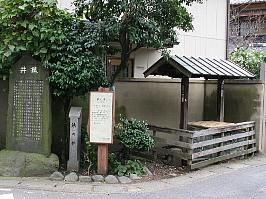 In the corner here, under the little roof is the Kurogane-no-I, or the Iron Well, one of the 10 most
famous wells in old Kamakura. Prior to the introduction of a city water service, people in the neighborhood
and passers-by benefited greatly from this well.
In the corner here, under the little roof is the Kurogane-no-I, or the Iron Well, one of the 10 most
famous wells in old Kamakura. Prior to the introduction of a city water service, people in the neighborhood
and passers-by benefited greatly from this well.
It got to be known by this name after the head section of an iron statue of the Kannon Goddess was found at the bottom of the well after a great fire that consumed this area and some Buddhist halls.
Later, the head part was transferred to Ningyocho (人形町) in Tokyo, where even now it is worshipped as the main image at Daikannonji Temple (大観音寺).
| Tsurugaoka Bunko Library (鶴岡文庫) |
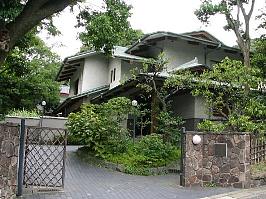 The Tsurugaoka Bunko library houses old documents belonging to the Tsurugaoka Hachiman Shrine and
other historical and cultural records relating to Kamakura. The library holds lectures throughout the year
on the history of this ancient city.
The Tsurugaoka Bunko library houses old documents belonging to the Tsurugaoka Hachiman Shrine and
other historical and cultural records relating to Kamakura. The library holds lectures throughout the year
on the history of this ancient city.
| Imamiya Shrine (今宮) |
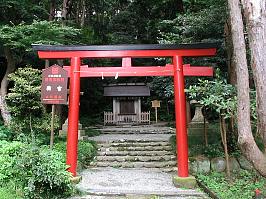 A stone tablet marks the site of a shrine that was known as Imamiya. In 1239, fights broke out
frequently in the town, with the riots of May 25th being particularly violent. This happened to be the day
when the Emperor Gotoba died on the island of Oki, in the Sea of Japan. He had been exiled there after
leading a failed attempt to bring down the Kamakura shogunate. People thought that the disturbances were
caused by the spirit of the dead emperor seeking vengeance, so a shrine was built here to appease his
spirit as well as those of his son Juntoku and grandson Chukyo.
A stone tablet marks the site of a shrine that was known as Imamiya. In 1239, fights broke out
frequently in the town, with the riots of May 25th being particularly violent. This happened to be the day
when the Emperor Gotoba died on the island of Oki, in the Sea of Japan. He had been exiled there after
leading a failed attempt to bring down the Kamakura shogunate. People thought that the disturbances were
caused by the spirit of the dead emperor seeking vengeance, so a shrine was built here to appease his
spirit as well as those of his son Juntoku and grandson Chukyo.
|
The former site of Nijugobo, Twenty-Five Boarding House for Monks (二十五坊) |
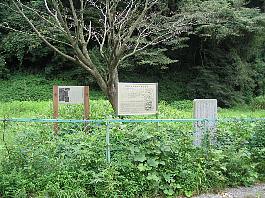 The stone monument indicates the site of Nijugobo, where there were 25 boarding houses for monks.
Until the early Meiji period, Tsurugaoka Hachiman incorporated both Shinto and Buddhist beliefs and was
known as Tsurugaoka Hachimanguji, that is, Hachiman Shrine and Temple. In those days, Tsurugaoka
Hachimanguji was administered by monks and this is where they would have been housed. Nijugobo has the
notorious fame of being the place where the monk Kugyo took refuge, after slaying the third shogun Sanetomo
in the 13th century.
The stone monument indicates the site of Nijugobo, where there were 25 boarding houses for monks.
Until the early Meiji period, Tsurugaoka Hachiman incorporated both Shinto and Buddhist beliefs and was
known as Tsurugaoka Hachimanguji, that is, Hachiman Shrine and Temple. In those days, Tsurugaoka
Hachimanguji was administered by monks and this is where they would have been housed. Nijugobo has the
notorious fame of being the place where the monk Kugyo took refuge, after slaying the third shogun Sanetomo
in the 13th century.In 1872, the Meiji government ordered the separation of Shintoism and Buddhism, and Tsurugaoka Hachiman Shrine and Temple became just a shrine, and the monks became Shinto priests.
This is the scene of many historical events, and it is also significant as the birthplace of the Ancient Capital Preservation Law. After the Second World War, a housing project was mapped out for this area, but the citizens of Kamakura mounted a campaign against the plan. In the end the area was saved and kept as it was. Their activities brought about the enactment of the monumental law.
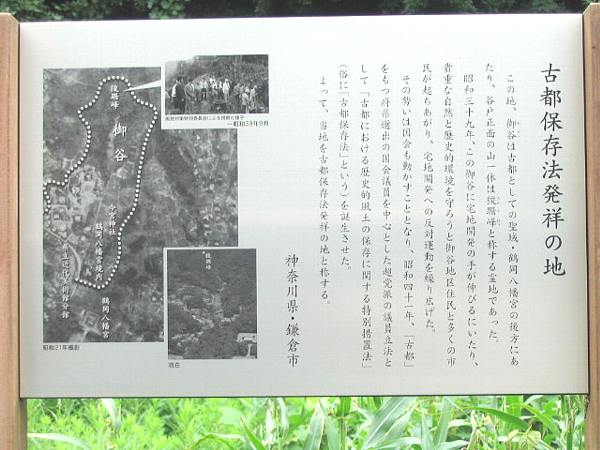
| Kobukurozaka Pass (巨福呂坂) |
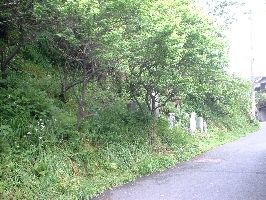
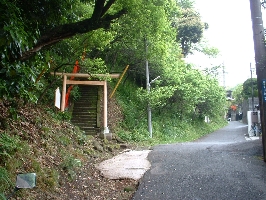
Location: One kilometer north of JR Kamakura Station.
Site: Kobukurozaka Pass was one of the seven passes leading into old Kamakura. The present one was constructed around 1883 and the old path, although closed at the hillside now, partly runs parallel to the new one.
The old one started from the west side of the Hachimangu Shrine grounds, and ran up the hillside in front of Omeshoten Shrine (青梅聖天), and led to the front of Ennoji Temple (円応寺), afterwards emerging in front of Kenchoji Temple (建長寺). Part of the trail is designated a Historic Site by the government.
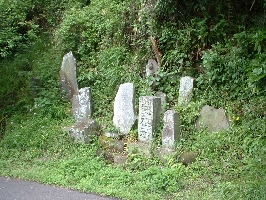
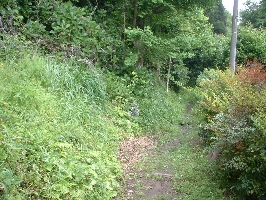
Story: When Kamakura was attacked by the forces of Nitta Yoshisada (新田義貞, 1301-38) in 1333, this became one of the three routes through which the enemy of the Hojo government rushed into the center of the city.
Area: Yukinoshita - 2
|
The Former Site of the Residence of Hatakeyama Shigetada (畠山重忠の屋敷跡) |
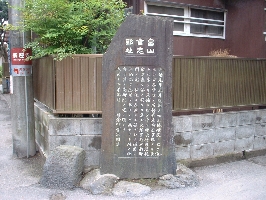
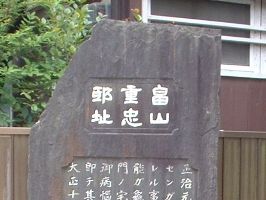
Location: One kilometer northeast of JR Kamakura Station and close to the east gate of the Hachimangu Shrine. Nearby is Yokohama Kokuritsu Daigaku Fuzoku Sho-Chugakko (横浜国立大学付属小、中学校, the Elementary and Junior School Annex of Yokohama National University).
Site: The residence of Hatakeyama Shigetada (畠山重忠, 1164-1205), an important Yoritomo retainer, once stood to the south of the school. A stone monument marks the site.
History: When Yoritomo rose up in arms against the Taira (平), Shigetada, in Musashi Province (武蔵 , now part of Tokyo and Saitama Prefecture), first sided with the Taira clan. After he surrendered to Yoritomo, Shigetada took a prominent part in Yoritomo's war against the Taira. He soon gained Yoritomo's trust and became a high-ranking vassal in the government.
Later, however, relations between Shigetada and the shogunal regent, Hojo Tokimasa (北条時政, 1138- 1215) soured because of Hojo's ambition to gain full control. In 1205, Shigetada was tricked into rising against the Hojo. Following the death of his son in battle against the Hojo, Shigetada took up arms against them and was killed in another battle later the same year.
|
The Former Site of the Residence of Miura Yoshimura (三浦義村の屋敷跡) |
Location: One kilometer northeast of JR Kamakura Station. It corresponds approximately to the grounds of Fuzoku Sho-Chugakko School.
Story: The Miura, a powerful warrior family of Sagami Province (相模, most of present-day Kanagawa Prefecture), was the mainstream of the Taira family. However, Miura Yoshiaki (三浦義明, 1092-1180), supported Yoritomo's uprising in 1180, with his son, Yoshizumi (義澄, 1127-1200), his grandson, Yoshimura (義村, ? -1239), and other family members.
Following Yoritomo's victory over the Taira and the founding of the bakufu, Yoshimura became an influential retainer of the government and was given a residence near the government offices. Yoshimura supported the government with the Hojo family. Even when his cousin Wada Yoshimori (和田義盛, 1147-1213) opposed the Hojo, Yoshimura, after due deliberation, took their side.
The Miura thus came to rank second to the Hojo after the obliteration of the Hatakeyama and the Wada. Yoshimura's son, Miura Yasumura (泰村, ?-1247), married a daughter of Hojo Yasutoki (北条泰時, 1183-1242). In 1247, however, he was forced into rebellion by the Hojo, who, wanting to consolidate their position in the government, had a policy of eliminating rivals, real or imagined. Defeated in battle, Yasumura committed suicide at Hokkedo Hall (法華堂) in Okura (大蔵) with more than 250 of his followers.
| Sujikaebashi Bridge (筋違橋) |
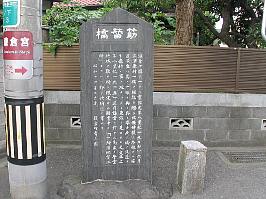 Right at the corner where the road makes a sharp turn, there used to be a bridge that spanned a river
on the diagonal. Because of this unusual layout, it was called Sujikaebashi, literally "Oblique-span
Bridge." It was famous as one of the ten major bridges of old Kamakura, but it was removed in a major
reconstruction of the road in 1955 and the river covered over. The only reminder of the site is the nearby
stone monument.
Right at the corner where the road makes a sharp turn, there used to be a bridge that spanned a river
on the diagonal. Because of this unusual layout, it was called Sujikaebashi, literally "Oblique-span
Bridge." It was famous as one of the ten major bridges of old Kamakura, but it was removed in a major
reconstruction of the road in 1955 and the river covered over. The only reminder of the site is the nearby
stone monument. Also nearby stood the Miura residence. The Miura, a very influential family, made important contributions to the founding of the Kamakura military government.
In 1247 the bridge witnessed a battle between the Miura and Hojo clans. The Hojo clan held the role of regent in Kamakura and they were fearful of the increasing power of the rival Miura. So they carried out a preemptive strike against the Miura residence. After fierce street fighting, the Miura were defeated. Those who survived the attack fled into a hall called Hokkedo and committed suicide en masse.
| The Former Site of the Mongaku Residence (文覚上人屋敷跡) |
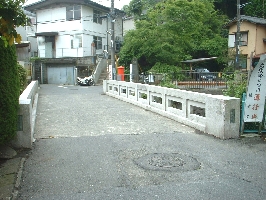
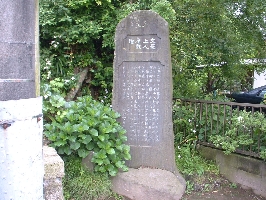
Location: The site of the Mongaku residence is marked by a stone monument next to the Omidobashi Bridge (大御堂橋).
Story: The main person in this story is Endo Morito (遠藤盛遠). He was originally a warrior in Kyoto and later became a monk, taking the Buddhist name, Mongaku. When he was young, he mistakenly killed a married women, named Kesagozen (袈裟御前). She was the wife of his friend, Minamoto no Wataru (源渡). The two had fallen in love. Much worried about the situation, she asked Morito to come to her home at night and kill her husband while he was asleep. Morito agreed to this plot and carried it out. Alas, it was not Wataru that he killed but Kesagozen herself. To show his repentance, Morito entered the priesthood.
Despite this vocation, he reportedly never lost his fiery temper. As a result of his coercive attitude towards the emperor, Mongaku was exiled to Izu (the eastern part of what is now Shizuoka Prefecture) in 1178, where, coincidentally Yoritomo had been in exile since 1160. The two often met and formed close ties.
One story has it that Mongaku urged Yoritomo to take up arms against the Taira. He said persuasively, "Your father Yoshitomo (義朝, 1123-60) was killed by the Taira, and you were exiled by them. All your sufferings were brought about by your sworn enemy, Taira no Kiyomori (平清盛, 1118-81)." At first, Yoritomo was reluctant, but in the end he was moved by these words. Even after Yoritomo set up the bakufu, the association between the two men continued for a long time
| The Former Site of Shochojuin Temple (勝長寿院跡) |
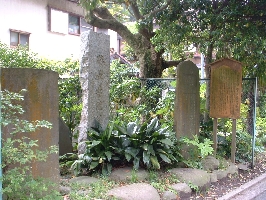
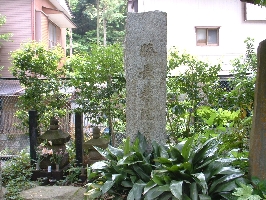
Location: A little more than one kilometer northeast of JR Kamakura Station.
Site: A large stone monument and other stones mark the former site of Shochojuin Temple.
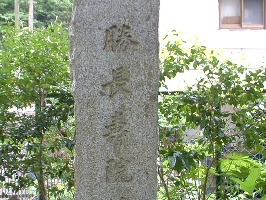
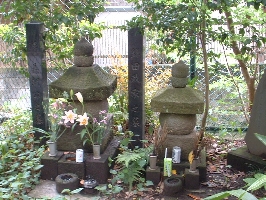
Story: Minamoto no Yoritomo (源頼朝) had a long-pending project in his mind while he was fighting against the Heike and establishing his government. This was to create a suitably grand temple for the repose of the soul of his father, who had died an ignominious death, and eventually, in 1185, Yoritomo had the temple completed at this site.
His father Yoshitomo (義朝, 1123-1160) had been a leading warrior in Kyoto. Yoshitomo and Taira no Kiyomori (平清盛, 1118-81) had fought on the same side in the Hogen Disturbance (保元の乱) of 1156. But soon after, they became rivals. In the 1159 Heiji Disturbance (平治の乱), Yoshitomo was defeated by Kiyomori and tried to flee from Kyoto to the east. However, he was betrayed and killed by a man he had trusted. The man was still under the influence of the Heike.
Some 20 years later, Yoritomo asked the cloistered Emperor Go-Shirakawa (後白河法皇, 1127-92) to permit the construction of a mausoleum for Yoshitomo. In response, the Emperor had Yoshitomo's head found and sent to Yoritomo in 1185. The temple dedicated to Yoshitomo was said to have been truly grand.
The third shogun, Sanetomo (源実朝, 1192-1219), had close ties with this temple. On a visit one rainy spring morning, he composed a poem, which roughly translates as follows:
In this old temple,
Flowers on the decaying plum tree come forth,
Enticed by the drizzling spring rain.
On January 28, 1219, the day following his assassination, Sanetomo was buried here. Prior to his departure to Hachimangu Shrine where he met his death, he composed a poem of farewell, which suggests to us that Sanetomo was aware of the fate that awaited him.
A gorinto-type stupa, said to be Yoshitomo's tombstone, also once stood here, but there is now no trace of it or of the temple itself. Shochojuin, Tsurugaoka Hachimanguji (鶴岡八幡宮寺) and Yofukuji (永福 寺) Temple were counted among "the three major temples of Kamakura", but Shochojuin was destroyed in the Muromachi period.